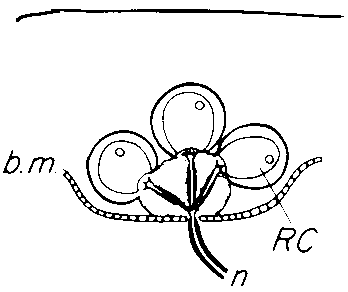Knollenorgan on:
[Wikipedia]
[Google]
[Amazon]
 A Knollenorgan is an
A Knollenorgan is an
 A Knollenorgan is an
A Knollenorgan is an electroreceptor
Electroreception and electrogenesis are the closely-related biological abilities to perceive electrical stimuli and to generate electric fields. Both are used to locate prey; stronger electric discharges are used in a few groups of fishes to stu ...
in the skin of weakly electric fish
An electric fish is any fish that can generate electric fields. Most electric fish are also electroreceptive, meaning that they can sense electric fields. The only exception is the stargazer family. Electric fish, although a small minority, in ...
of the family Mormyridae
The Mormyridae, sometimes called "elephantfish" (more properly freshwater elephantfish), are a Mormyridae (superfamily) , family of Electric fish , weakly electric freshwater fish in the order Osteoglossiformes native to Africa. It is by far the ...
(Elephantfish) from Africa. The structure was first described by Viktor Franz (1921), a German anatomist unaware of its function. They are named after "Knolle", German for "tuberous root" which describes their structure.
Structure and function
Knollenorgans contain modifiedepithelial cells
Epithelium or epithelial tissue is one of the four basic types of animal tissue, along with connective tissue, muscle tissue and nervous tissue. It is a thin, continuous, protective layer of compactly packed cells with a little intercellula ...
that act as sensory transducers for electric fields. Besides these, there are supporting cells and a sensory neuron
Sensory neurons, also known as afferent neurons, are neurons in the nervous system, that convert a specific type of stimulus, via their receptors, into action potentials or graded potentials. This process is called sensory transduction. The cell ...
. The neuron projects to the fish's brain, specifically to the nucleus of the electrosensory lateral line
The lateral line, also called the lateral line organ (LLO), is a system of sensory organs found in fish, used to detect movement, vibration, and pressure gradients in the surrounding water. The sensory ability is achieved via modified epithelial ...
lobe (nELL) of the medulla
Medulla or Medullary may refer to:
Science
* Medulla oblongata, a part of the brain stem
* Renal medulla, a part of the kidney
* Adrenal medulla, a part of the adrenal gland
* Medulla of ovary, a stroma in the center of the ovary
* Medulla of t ...
via the posterior branch of the lateral line nerve.
The organs are embedded in the thickened epidermis
The epidermis is the outermost of the three layers that comprise the skin, the inner layers being the dermis and hypodermis. The epidermis layer provides a barrier to infection from environmental pathogens and regulates the amount of water rele ...
. The receptor cells lie buried in the deeper layers of the epidermis, where they expand into a pocket in the superficial layers of the corium. The sense organ is surrounded by a basement membrane which separates corium from epidermis. Epithelial cells form a loose plug over the sensory receptor
Sensory neurons, also known as afferent neurons, are neurons in the nervous system, that convert a specific type of stimulus, via their receptors, into action potentials or graded potentials. This process is called sensory transduction. The cell ...
s, allowing capacity-coupled current to pass from the external environment to the sensory receptor.
Knollenorgans lack the jelly-filled canal leading from sensory receptor cells to the external environment characteristic of the Ampullae of Lorenzini
Ampullae of Lorenzini (singular ''Ampulla'') are electroreceptors, sense organs able to detect electric fields. They form a network of mucus-filled pores in the skin of cartilaginous fish (sharks, rays, and chimaeras) and of basal actinopterygia ...
found in shark
Sharks are a group of elasmobranch fish characterized by a cartilaginous skeleton, five to seven gill slits on the sides of the head, and pectoral fins that are not fused to the head. Modern sharks are classified within the clade Selachimo ...
s and other basal group
In phylogenetics, basal is the direction of the ''base'' (or root) of a phylogenetic tree#Rooted tree, rooted phylogenetic tree or cladogram. The term may be more strictly applied only to nodes adjacent to the root, or more loosely applied to nodes ...
s of fishes. Knollenorgans are sensitive to electrical stimuli at frequences between 20 hertz and 20 kilohertz
The hertz (symbol: Hz) is the unit of frequency in the International System of Units (SI), equivalent to one event (or cycle) per second. The hertz is an SI derived unit whose expression in terms of SI base units is s−1, meaning that one h ...
, with electric fields as small as 0.1 millivolt
The volt (symbol: V) is the unit of electric potential, electric potential difference (voltage), and electromotive force in the International System of Units (SI). It is named after the Italian physicist Alessandro Volta (1745–1827).
Definit ...
per centimetre. They are used to detect the weak electric organ discharges of other electric fish, usually of their own species.
See also
*Ampullae of Lorenzini
Ampullae of Lorenzini (singular ''Ampulla'') are electroreceptors, sense organs able to detect electric fields. They form a network of mucus-filled pores in the skin of cartilaginous fish (sharks, rays, and chimaeras) and of basal actinopterygia ...
– the ancestral type of electroreceptor in vertebrates
References
{{Electric fish Fish physiology Neuroethology Fish nervous system Electric fish